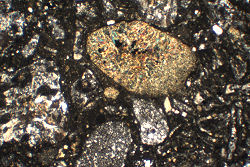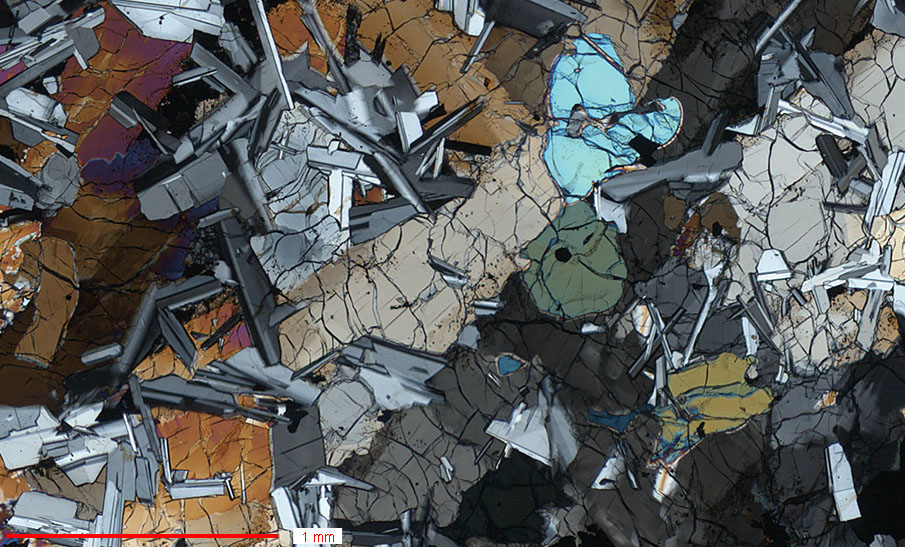|
|
Post by washingtonrocks on Jan 14, 2015 20:37:28 GMT -5
snowmom, I haven't taken any photos of my gabbro, but a quick internet search gave me a nice macro shot of what I'm referring to. An altered plagioclase crystal in basalt. Looks a bit like what I'm seeing in yours, but of course it could anything really.  You've probably touched on this already, but in regards to the ID of the other minerals in your rocks, Hypersthene might be a likely candidate.
|
|
|
|
Post by snowmom on Jan 15, 2015 5:39:56 GMT -5
washingtonrocks, I think I have seen it before. I get the idea, though... will look deeper. Thanks for the hint on Hypersthene... will take a look into that one too!
|
|
jamesp
Cave Dweller 
Member since October 2012
Posts: 36,612
|
Post by jamesp on Jan 15, 2015 5:55:23 GMT -5
washingtonrocks-Why do they slice basalt thin and backlight it to use polarized light ? It is some sort of diagnosis method, but not sure what it highlights. I found this: "Thin-sections are carefully prepared glass slides suitable for mineralogical and petrology studies when viewed through a microscope. They are thin slices that have been carefully ground down and polished so thinly that light can pass through the mineral structures. In transmitted light, thin sections reveal the texture and crystal shape of minerals and other identifying characteristics while through polarized light, the mineralogy is awash in color allowing for more complete mineral identification." I guess that answers the question, but what to compare the "texture and crystal shape of minerals" to ?? an example, Sudbury black Onaping impactite:  I sliced a piece of snowmom's black impactite to 2mm, but not thin enough to hardly pass light. Will try slicing a smaller piece thinner, thin slices can damage the ole saw blade if it runs out of the groove.
|
|
|
|
Post by vegasjames on Jan 15, 2015 6:16:03 GMT -5
|
|
jamesp
Cave Dweller 
Member since October 2012
Posts: 36,612
|
Post by jamesp on Jan 15, 2015 6:29:00 GMT -5
Thanks vegasjames. I get it, encased in epoxy and then ground (to very thin). Have played with a polarizer, what a color generator. Your images magnify the polarizing effect much better, unique tool to see crystal strucure/shape. Supposing if you grind any sample of a rock thin enough light will pass thru it and revelations can be made. If you google 'polarized images of basalt' kaleidoscopic barrage of images comes up. Too cool Included in those images are Apollo photos of apparently basalt from the moon ? Talk about some fine photography, scale is 60mm on my screen, so 60X magnification, probably an electron microscope:  |
|
jamesp
Cave Dweller 
Member since October 2012
Posts: 36,612
|
Post by jamesp on Jan 15, 2015 6:49:30 GMT -5
Gabbro is a name originally bestowed by the Italians to a type of serpentine, but the term is now generally utilized to describe a coarsely grained igneous rock chemically equivalent to basalt. Widely distributed on Earth and the moon, gabbro is sometimes mined in quarries for use in the building industry, but is much more valuable as a source of copper, nickel, cobalt, platinum, and iron ores. Gabbro:   Darkly or greenish colored, gabbro is an intrusive rock formed when molten magma becomes trapped in cracks or other layers of rock and gradually cools into a rigid, crystalline mass. The mineral material occurs in large bodies and is common in various locations, such as South Africa, Sudbury, Ontario, Scotland’s Isle of Skye, and the Adirondack Mountains in New York. A relatively dense rock, gabbro is primarily composed of pyroxene and plagioclase feldspar, but olivine, amphibole, and quartz may also be present. Numerous important minerals are also associated with gabbro, and many deposits, such as those found in Lake Superior, have been mined for many years, contributing greatly to local economies in such areas. |
|
|
|
Post by washingtonrocks on Jan 15, 2015 16:47:48 GMT -5
|
|
|
|
Post by snowmom on Jan 15, 2015 17:37:37 GMT -5
washingtonrocks, there are a thousand things here, all not native to the area. It is going to take a while to learn all the different material and try to sort it all out. I haven't seen things quite like that here (yet) but I imagine if I look long enough i'll spot some eventually! We do have bioclasts in limestone all over, but it is just grey with sometimes shades of greenish gray. Nothing as colorful as these images! There seems to be a good deal of difference in the fragment types in the other breccias, and with our limestone, that alone is a dead giveaway that it is going to be some sort of fossil material.
The matrix shown in the black based rock and the grey green rock is completely different, much more like a chalcedony or jasper than a dolostone of any sort.
Lots to sort out. Hopefully we can pick up a few professional opinions as the attempt to solve the mystery continues. I am trying to make order out of my files and photographs so that I can present a coherent story with details, observations and well chosen questions. I am compiling a list of emails of collectors, dealers, museums and specialists and will send the query to each of them when I am satisfied with the documentation and notes, etc. We're getting there!
|
|
Deleted
Deleted Member
Member since January 1970
Posts: 0
|
Post by Deleted on Jan 15, 2015 17:47:10 GMT -5
Digger Odel
Jim
|
|
Deleted
Deleted Member
Member since January 1970
Posts: 0
|
Post by Deleted on Jan 15, 2015 22:37:18 GMT -5
so perfectly executed it looks computer generated.  Please keep up the discussion boys and girls. |
|
Deleted
Deleted Member
Member since January 1970
Posts: 0
|
Post by Deleted on Jan 15, 2015 22:47:29 GMT -5
This link has a few macros of very similar Onaping breccia. The meteorite folks really get in to the breccias too. Thin slices for ability to use polarized light. checkout the prices they get on those autoclaved slides, we in wrong biz www.meteorlab.com/METEORLAB2001dev/offering21o9a.htmActually, if you consider they sliced the stone very thin, then machined it to 0.030" please don't ask me why I know this. But I do. and finished it to high polish on two sides, those slides are quite reasonably priced. I cannot believe it would take less than 2 hours to make one. They use tile saws to make blocks and then use a 3-4" (or so) drop saw with super thin; 0.006" thick diamond blade to make sections for surface prep and polish x2 sides. Even when working in batches, the time spent on each one adds up. One gent I spoke to (years ago) claimed he could to about ten per day, but if he has one or more break, his output is killed. |
|
jamesp
Cave Dweller 
Member since October 2012
Posts: 36,612
|
Post by jamesp on Jan 15, 2015 23:24:43 GMT -5
This link has a few macros of very similar Onaping breccia. The meteorite folks really get in to the breccias too. Thin slices for ability to use polarized light. checkout the prices they get on those autoclaved slides, we in wrong biz www.meteorlab.com/METEORLAB2001dev/offering21o9a.htmActually, if you consider they sliced the stone very thin, then machined it to 0.030" please don't ask me why I know this. But I do. and finished it to high polish on two sides, those slides are quite reasonably priced. I cannot believe it would take less than 2 hours to make one. They use tile saws to make blocks and then use a 3-4" (or so) drop saw with super thin; 0.006" thick diamond blade to make sections for surface prep and polish x2 sides. Even when working in batches, the time spent on each one adds up. One gent I spoke to (years ago) claimed he could to about ten per day, but if he has one or more break, his output is killed. yep. good point. Lots of tedious labor on those. |
|
sheldon74
having dreams about rocks

Member since May 2013
Posts: 59
|
Post by sheldon74 on Jan 16, 2015 21:32:35 GMT -5
Hi everyone. I was going to post a picture of my piece that is very similar to snowmoms. (I live close to Sudbury). Could not find the picture and mine is buried outside under 3 feet of snow but here is a link to a website of what I believe is the same material called Bannockburn Porphyry. www.rocksforkids.com/R&M/bannockburn_porphyry.htmAlso, there is no doubt at all that in one of the previously posted pictures suspecting that there may be nickel in it is in fact nickeline or nicollite. It is very common around this area. Sheldon |
|
|
|
Post by snowmom on Jan 17, 2015 5:53:02 GMT -5
Sheldon, Hello Neighbor! welcome to the boards. you are about to become a relied upon information source for all things Sudbury. That does indeed look very similar to the rock posted here, most of this one has a greenish cast, and the pieces are quite small though, compared to the photos in the link you attached. Does the Bannockburn material come that way too? I know almost anything you find there will be wildly varied. Glad you are with us. Yes,we would love to see pictures "after the thaw" . thank you.
I'd love to see you start another thread in one of the main forums with photos of your local finds. Thanks for the input.
|
|
|
|
Post by snowmom on Jan 17, 2015 6:38:39 GMT -5
|
|
|
|
Post by snowmom on Jan 17, 2015 6:51:24 GMT -5
Sheldon, whoops, I see your membership to RTH is about a year older than mine. mostly lurking? Come out to play! I have a feeling I could learn a lot from you!  |
|
jamesp
Cave Dweller 
Member since October 2012
Posts: 36,612
|
Post by jamesp on Jan 17, 2015 7:37:46 GMT -5
|
|
spiritstone
Cave Dweller 
Member since August 2014
Posts: 2,061 
|
Post by spiritstone on Jan 18, 2015 21:41:31 GMT -5
Take a peek at these thin slices of art. Beautiful stuff. Tom Phillips Thin Sections ------------------------- Meteorite & Rock Art These images are presented as "ART". Some people may take exception to calling this "ART". I guess that is up to each person. tomphillipsrockart.blogspot.ca/ |
|
|
|
Post by snowmom on Jan 19, 2015 5:49:50 GMT -5
Take a peek at these thin slices of art. Beautiful stuff. Tom Phillips Thin Sections ------------------------- Meteorite & Rock Art These images are presented as "ART". Some people may take exception to calling this "ART". I guess that is up to each person. tomphillipsrockart.blogspot.ca/well, people take pictures of other bits of nature (scenery, etc) and use special filters, lenses, and effects, and that is considered art. If Tom Phillips takes pictures of natural material using special filters and lenses, I think it must fit into the same category. Some of those are just gorgeous. That was a pleasure to view. thanks for the link!
|
|
jamesp
Cave Dweller 
Member since October 2012
Posts: 36,612
|
Post by jamesp on Jan 19, 2015 7:46:46 GMT -5
Take a peek at these thin slices of art. Beautiful stuff. Tom Phillips Thin Sections ------------------------- Meteorite & Rock Art These images are presented as "ART". Some people may take exception to calling this "ART". I guess that is up to each person. tomphillipsrockart.blogspot.ca/Oh yea |
|